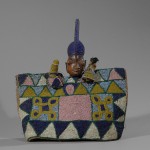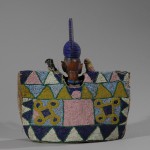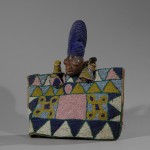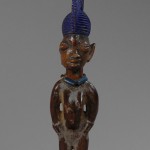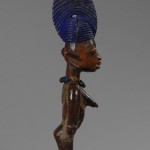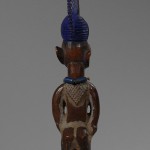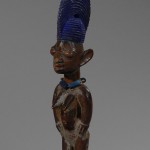EDC 0715-03
Female “ere ibeji” twin figure in beaded coat, Yoruba, Nigeria
H: 20 cm (7,9”), W: 30 cm (11,8”)
This exceptional specimen of a ‘ere ibej’ figure is dressed in a miniature version of the costume worn by a priest of the god Shango.
The costume is made of several layers of cloth sewn and embroidered with hundreds of polychrome miniature glass beads. A similar example published by R.F. Thompson indicates that pieces like this one was made by the carver Amos Lafia in Ibadan. The glass-bead ornamentation of the costume symbolizes Mpatapo “Knot of pacification/reconciliation”.
The figure rises from a circular base, it has rounded shoulders and arms merged with the upper leg. The schematic female body with back tattoos and a fine chain with blue glass beads around the neck is crowned by a big head with a high classical Abeokuta coiffure, dyed with indigo paint.
Age: Est. beg. 20th Century
Provenance: The Dessau Collection, France
Literature: Eric Herold; “Africa Art” 1989 (P.102). Robert Farris Thompson; “Black Gods and Kings” 1959. Bascom, W. (1973). “African art in cultural perspective”. Bolajildowu, E. (1973). African traditional religion. A definition. Nylander, P. P. S. (1979). “The twinning incidence in Nigeria”. Olaleye-Oruene, T. (1983). “Cultic powers of Yoruba twins”. Zuring, J. (1977). “Tweelingen in Afrika” [Twins in Africa]. Tilburg, Holland: H. Gianotten. “Twin Research” April 2002
Click here for more information about the Yoruba people
Request price for Ibeji Twin
